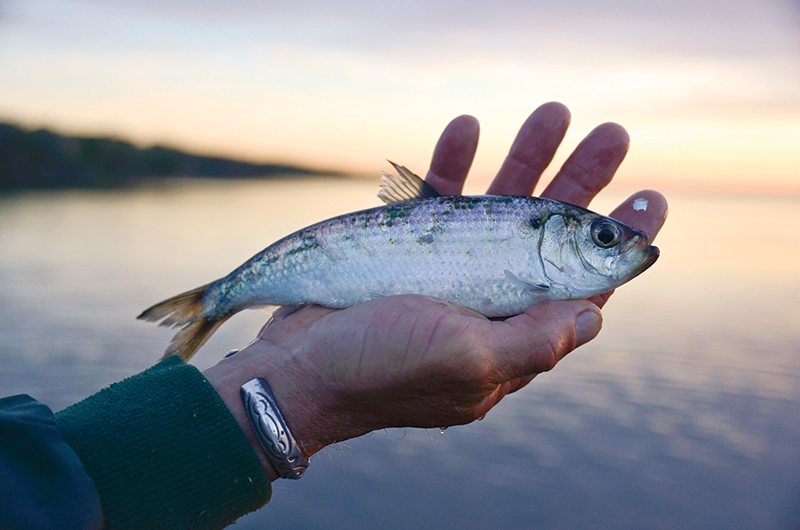Ancient practices are meeting modern technology at the herring creek. There, the Wampanoag Tribe of Gay Head (Aquinnah) and a team of researchers is embarked on a two-year project that utilizes tagging technology to study the natural conditions that affect river herring in the Squibnocket Pond watershed. The goal is to develop restoration strategies to stem the precipitous decline of a fish embroidered into tribal culture and tradition.
Alewives and blueback herring, collectively known as river herring, are anadromous fish, meaning that they are born in fresh water but spend most of their adult lives at sea. Juvenile herring depart the pond in the fall imprinted with the map they will follow when it is their time to play their part in the ancient cycle of procreation. They return in three to five years to spawn.
Historically, river herring spawned in most rivers and tributaries along the Atlantic coast. Since colonial times, the blockage of spawning rivers by dams and other impediments, combined with habitat degradation and overfishing, have severely depleted river herring populations. In 2005, following a particularly dramatic decline in returning river herring along the East Coast, fisheries managers imposed significant harvest restrictions as part of a broad-based restoration effort. Massachusetts imposed a moratorium on the harvest and sale of herring, which remains in effect.
However, members of federally recognized tribes are allowed to take herring for sustenance, and the Island’s Wampanoag Tribe has taken a leading role in attempts to restore the stocks. As part of that, on a chilly evening in early May, members of the Wampanoag Natural Resources Department and project leader Asha Ajmani, a doctoral student at the University of Massachusetts at Amherst, demonstrated the work underway for a gathering of tribal elders and Islanders.
Working quickly, Abigail Archer, a fisheries and aquaculture specialist, removed a herring from a rectangular holding tank. In a sprinkle of reflective scales, she held the squirming fish down on a board with an inset ruler. After its size and sex were recorded, Ajmani made a small incision with a scalpel. She inserted a passive integrated transponder (PIT) tag, the size of a vitamin capsule, into the herring’s body cavity. Archer then gave the incision area a gentle rub, and tribal laboratory manager Andrew Jacobs carried the fish back to the creek where it would continue its journey to its natal fresh waters in Squibnocket Pond.
The PIT tag works in a similar way to the vehicle transponders used to assess tolls. Antennas placed in twelve locations in the Squibnocket watershed track the herring’s movements and allow researchers to identify their preferred spawning habitat. They’ll also be able to determine when and if individual herring return to the sea and will provide information on annual returns. By the end of the May evening, the team had tagged ninety-three herring. In all, they have tagged about 500 fish.
A Northeast Climate Adaptation Science Center fellow, Ajmani said the knowledge gained would allow the Tribe and its partners to improve the spawning habitat in the watershed. A long-term goal is to restore a sustainable fishery for tribal members.
Wampanoags have harvested river herring for food, bait, and fertilizer for millennia from the Island’s once numerous runs. The annual spring migration signaled the end of a long winter and was an eagerly awaited event in Native American and later colonial culture.
“It may be difficult to think about lean times with our supermarkets and shipments of food, but herring meant the bountiful time has begun,” said Bettina Washington, the Tribe’s Historic Preservation officer. “There was a time when all the town would be speaking of the herring; nearly every home smelled of herring. There was a deep appreciation for the herring and recognition of the short time it was here.”
Bret Stearns, the Tribe’s Natural Resources Department director, said the tagging program, funded by the Bureau of Indian Affairs, is a natural outgrowth of the ongoing restoration and research effort. In 2016, the Tribe installed a video camera and counter to monitor species traveling through the run. In early spring, the Tribe completed a dredging project begun last year to remove silt and sand that had built up in the creek over decades.
The Tribe hopes to learn if herring are spawning successfully, if there’s enough space to spawn, and if water quality is sufficient for the spawning event. Based on that information, Stearns said, the Tribe can work with other landowners and partners to improve habitat.
Stearns said that annually over the last five years, approximately 37,500 fish returned. “That’s not a big number considering that at one point this pond held about one million fish easily,” he said. “Our job is to ensure that we have this resource into the future.”





